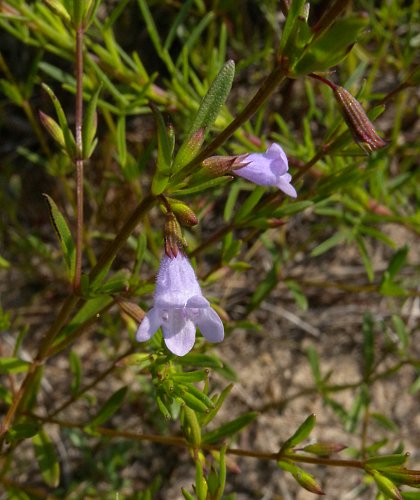
Solitary flowers develop from the axils of the leaves. Because such flowers can develop from primary, secondary, and even tertiary leaves, they often appear to occur in clusters (up to 6 flowers per node). Each flower is about 12 mm. (½") long, consisting of a pale lavender (rarely white) trumpet-shaped corolla with 2 lips, a light green to reddish purple calyx that is tubular in shape with 5 teeth, 4 stamens with pale lavender anthers and white filaments, and a pistil with a single divided style. The corolla is slightly compressed (flattened), becoming wider toward its lips; the upper lip consists of a pair of adjacent upper lobes that are erect-recurved, while the lower lip consists of 3 lower lobes that are slightly descending and spreading. All of these lobes have rounded margins. The outer upper surface of the corolla is finely hairy. Two stamens are slightly exserted near the upper lip, while the remaining pair of stamens are inserted. The style is also inserted within the corolla.
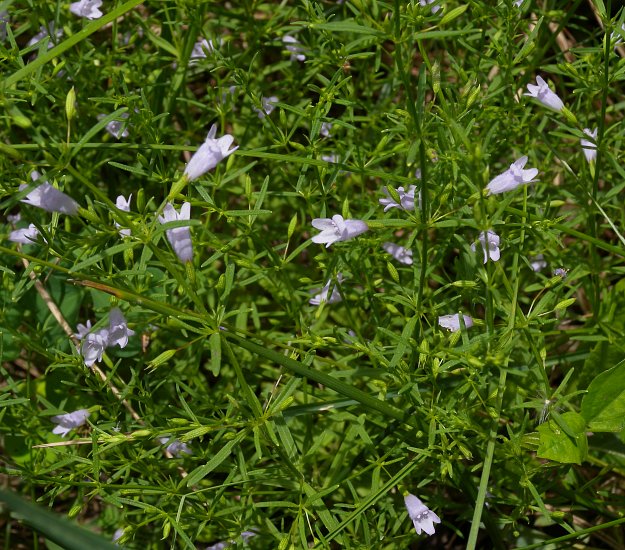
The tubular calyx is about one-third the length of the corolla; it is slightly compressed (flattened) and there are 10 fine longitudinal ribs along its length. The teeth of the calyx are narrowly triangular. The slender pedicels of the flowers are 6-10 mm. (about 1/3") in length. The blooming period occurs from early to late summer, lasting about 2-3 months. Afterwards, the flowers are replaced by small nutlets (4 nutlets per flower). These nutlets are up to 1 mm. across, brown, and finely pitted. The root system is fibrous and stoloniferous. Outside of the main growing season, this plant also produces a low rosette of basal leaves; the latter are substantially wider than the opposite leaves.
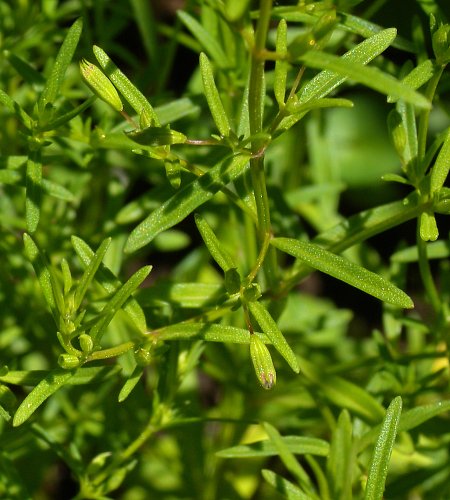
Cultivation: The preference is full or partial sun, moist to mesic conditions, and calcareous soil that is sandy or rocky. This plant could be cultivated in sunny rock gardens. It doesn't tolerate much competition from taller ground vegetation. Standing water is tolerated if it is temporary. During hot dry spells, this plant should be watered.
Range & Habitat: Low Calamint occurs primarily in NE Illinois, where it is uncommon and native (see Distribution Map). Rather oddly, this plant is widespread in Missouri, but it hasn't been found in southern Illinois. Habitats consist of mesic gravel prairies, sandy savannas, limestone glades, limestone cliffs, rocky areas along springs, moist sand flats along Lake Michigan, and fens. Low Calamint is found in high quality natural areas.
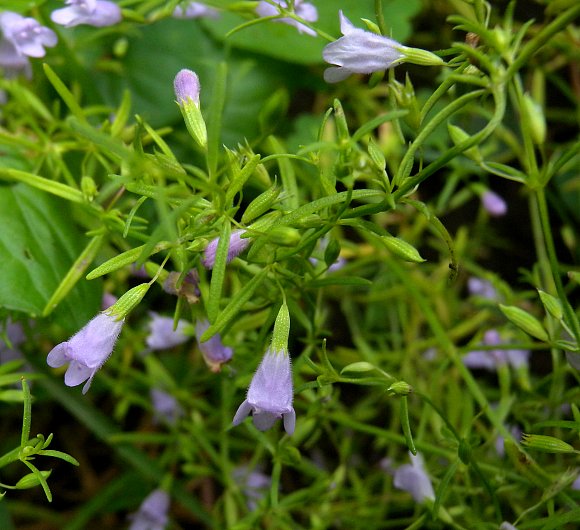
Faunal Associations: The flowers are probably cross-pollinated by bees. Both nectar and pollen are available as floral rewards. The larvae of a fly, Ophiomyia labiatarum, bore through the stems of Calamint species (Spencer & Steyskal, 1986). Because the foliage of this plant has a strong mint fragrance, it is probably avoided by mammalian herbivores.
Photographic Location: The wildflower garden of the webmaster, and the edge of a sand flat near Lake Michigan in NE Illinois.
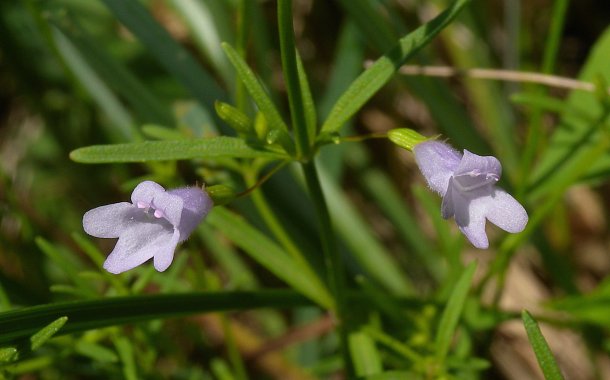
Comments: Low Calamint (Clinopodium arkansanum) has an unstable taxonomic history, and it has several scientific synonyms, including Satureja arkansana, Satureja glabella angustifolia, Calamintha arkansana, and Clinopodium glabrum. Another common name for this plant is Limestone Calamint. It is a bushy-looking little plant that becomes attractive during its peak flowering period (typically mid-summer), when numerous small flowers are in bloom at the same time. It also has a fairly long period of bloom. Low Calamint can be distinguished from similar plants by the strong mint fragrance of its crushed foliage, hairless or nearly hairless foliage, short narrow leaves without significant teeth, finely ribbed calyces, and solitary axillary flowers (although it can appear to have clusters of flowers if secondary and tertiary leaves are produced). Other species of plants in the Mint family that have foliage with a mint fragrance include mint, spearmint, and peppermint (Mentha spp.), and American Pennyroyal (Hedeoma pulegioides). Compared to Low Calamint, the various mints have wider leaves with conspicuous teeth and their flowers occur in dense axillary or terminal clusters. American Pennyroyal differs by having hairy stems, slightly wider leaves with petioles, and smaller flowers (about 6 mm. or ¼" in length) with shorter pedicels.